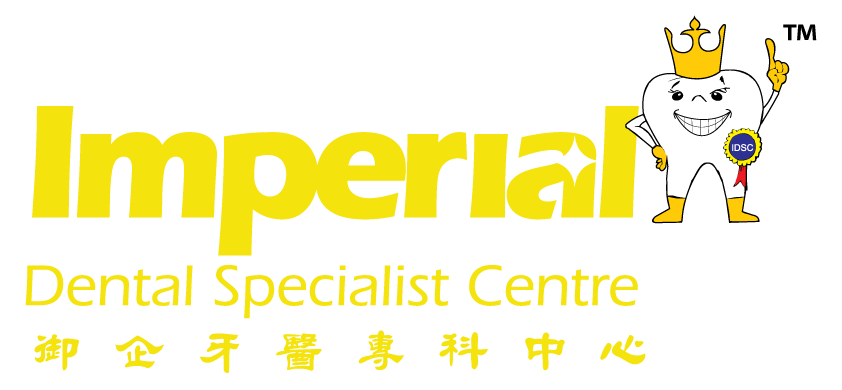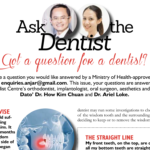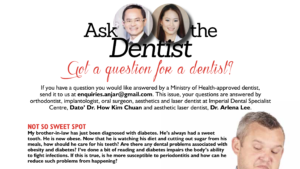
Dr How Kim Chuan and Ashwini Kholgade
ABSTRACT
A 43 year old male  patient presented with a fractured PFM crown extending subgingivally on tooth #21 which was previously endodontically treated. #11 was endodontically treated with mobile PFM crown. After clinical examination and evaluation of OPG and CBCT, it was indicated that restorability of both upper central incisors was poor. Therefore it
patient presented with a fractured PFM crown extending subgingivally on tooth #21 which was previously endodontically treated. #11 was endodontically treated with mobile PFM crown. After clinical examination and evaluation of OPG and CBCT, it was indicated that restorability of both upper central incisors was poor. Therefore it
was planned for extraction and followed by surgical placement of implant. This case report describes the flapless surgical placement of Zirconia dental implant for replacing maxillary central incisors. It also describes the biocompatibility, aesthetics and corrosion resistant properties of zirconium implant.
INTRODUCTION
A dental implant is a prosthesis that replaces the root of a natural tooth. This small screw-shaped device is placed into the jawbone. Over time, bone fuses with the implant to form a solid base. Metal-free dental implants are made of monolithic zirconia. This means that the implant and the abutment are constructed from one piece of incredibly strong white ceramic.
Osseointegration of zirconia dental implants may be comparable with that of titanium implants. Studies found that zirconia dental implant have low, well distributed and similar stress distribution when compared with titanium implants. Furthermore,
zirconia particles used for surface modifications of titanium implants may have the potential to improve initial bone healing and resistance to removal of torque. Although fabrication of surface modifications for zirconia is difficult, CO2 lasers revealed distinct surface alterations to zirconia and additional studies about this technique may help to improve surface roughness. Coated or surface-modified zirconia implants showed higher removal torque values than machined zirconia implants. To fulfill biomechanical requirements, restoring zirconia implants with high strength ceramics or metal ceramics would be beneficial.


CASE REPORT
43 years old male patient had chief complaint of fractured crown on #21. Clinical and radiographic evaluation revealed that #11 and #21 were endodontically treated (Figure 2). #21 had fractured PFM crown below the gum-line and #11 had mobile PFM crown. After taking OPG (Figure 2) and CBCT, patient advised that the teeth (#21 and #11) had poor restorability hence indicated for extraction.
TREATMENT OPTIONS FOR PROSTHESIS WERE
Option 1: A 6-unit FPD using teeth #12, #13 and #22, #23 as abutments.
Option 2: Surgical placement of dental implant for the replacement of the edentulous space at tooth #11 & #21 followed by crown which was to be a more conservative option. The pros and cons of each treatment option were explained to the patient. Patient decided to go with extraction and implant placement on the basis of long term success rate and preservation of adjacent teeth. The patient had no medical illness. Pre-operative extra-oral and intra-oral images were taken taken for diagnostic evaluation. (Figures 1a, 1b)
TREATMENT PLAN
1) Extraction of #11 and #21 under local anesthesia.
2) Placement of Zeramex dental implant on #11 and #21 after extraction socket healing.
3) Implant site allowed to heal followed by placement of prosthesis.
TREATMENT PROGRESS
Extraction of #11 and #21 was done under Local Anesthesia. The teeth were extracted atraumatically, taking care to preserve as much of the buccal plate and surrounding bone as possible (Figure 1b). Post extraction instructions were given to the patient and medication were prescribed. Provisional splinted acid etched bridge supported by #13, #12, #22, #23 was given for #11, #21 and patient was followed up.
After extraction site had healed for 8 weeks, implant placement procedure was carried out. CBCT (Figure 3) were taken for evaluation of bone quality and height. The implant osteotomy site was anesthetized with local infiltration in the area of #11 and #21. Flapless surgery was carried out and Zeramex implant system was used to place dental implants (Figure 4).
A round drill was used to make the initial penetration into bone for the implant site (Figure 5a). A small twist drill of 2.2mm in diameter was marked to indicate various lengths (i.e. Corresponding to the implant sizes) was used next, to establish the depth and align long axis of the implant recipient site (Figure 5b). A surgical guide pin was inserted to ensure proper positioning, and used throughout the procedure to direct the proper implant placement (Figure 6). 

This was followed by 2.8mm and 3.5mm diameter twist drills to prepare osteotomy site (Figures 7a, 7b). Drills were externally and internally irrigated. The twist drill was used at a speed of approximately 800 to 1500 rpm; refrigerated saline was used for copious irrigation to prevent overheating of the bone. Drill was intermittently and repeatedly pumped and pulled out of the osteotomy site while drilling to expose them to the water coolant and facilitate clearing bone debris from the cutting surfaces. The drills were pumped (up and down) intermittently and avoided a constant “push” of the drill in the apical direction only2. 3.5 mm Profile drill (Figure 8a) was used for osteotomy site and tap drill of 4.1 mm (Figure 8b) were used to create a nice implant bed to achieve good prognosis (Figures 7c, 7d). An implant fixture of 4.1mm body diameter and 12mm height by
Zeramex was inserted simultaneously at the implant sites of extracted #11 and #21 with precise interdental spacing and correct inclination3 (Figure 9). Implants mushroom heads were placed 1mm below the alveolar ridge like transmucosal implants for enhanced aesthetics (Figure 12b). Excellent primary stability was achieved. Cover screws were placed and flushed with the rest of the ridge to minimize the risk of exposure (Figure 10). Intra-oral and extra-oral photographs taken after surgical placement of Zeramex dental implant (Figures 11a, 11b).

An immediate peri-operative OPG (Figure 12a) and CBCT (Figures 13a, 13b) were taken for evaluation. Post-operative instructions were given to the patient and medication prescribed. Provisional splinted acid etched bridge supported by #13, #12, #22, #23 was given for #11, #21 (Figure 14). Patient was advised to maintain good oral hygiene and recalled for reviewing implants to check signs of infection and implant stability. The healing was uneventful. The surgical site was left undisturbed for 4 months.
Restorative procedure was carried out 4 months after the initial surgery. Cover screws were removed and implant heads were cleared. Closed tray impression technique
 was used. Dental analogs were subsequently fitted onto the impression copings and then inserted into PVS impression. The angle corrected zirconium abutments were selected and fitted onto the working model. Note that carbon fiber internal connection screws were used. It has been seen that carbon fiber screw is more sturdy and resistant to internal screw loosening than the titanium screw. Impression was made by using Impregum “Penta” Soft Polyether Impression Material (Figure 15).4
was used. Dental analogs were subsequently fitted onto the impression copings and then inserted into PVS impression. The angle corrected zirconium abutments were selected and fitted onto the working model. Note that carbon fiber internal connection screws were used. It has been seen that carbon fiber screw is more sturdy and resistant to internal screw loosening than the titanium screw. Impression was made by using Impregum “Penta” Soft Polyether Impression Material (Figure 15).4
The case was sent to lab for final fabrication of crowns with bite registration and shade A2 was selected. Abutments were placed on dental analogs and porcelain fused to zirconium crowns fabricated onto the zirconium abutments (Figures 16a, 16b). After three weeks, abutments were screwed on #11 and #21 implant (Figure 17), cementation of porcelain fused to zirconia crown was carried out (Figure 18). The crowns were checked for shade, interproximal contacts and occlusion followed by cementation with 3M Rely X resin
cement (Figure 18). There was a small triangular defect in between
#11 and #21 (Figure 18). Patient was reviewed 6 months later to

monitor if this triangular defect would creep up spontaneously.
It has been well documented of the gingival affinity of zirconium material.
Post-operative extra-oral & intra-oral images were taken (Figure 19).
Post-operative OPG was taken for evaluation (Figure 20).






RESULTS
Edentulous spaces with 11 and 21 teeth were successfully restored with zirconium implants (Figures 19, 20). The entire healing phase of the implant therapy was uneventful. 4 months after implant placement the region showed good soft tissue healing and new bone regeneration. Patient was pleased with the outcome and the esthetics were restored. The prosthesis remained stable and fully functional with good surrounding gingival health.
DISCUSSION
The use of dental implants in the maxillary anterior region to replace missing teeth is a viable treatment option. There are many benefits of fixed dental implant-supported prosthetics versus traditional crown and bridge or removable tooth-borne prosthetics. Maintenance of residual bone, ease of oral hygiene, increased longevity, and non-involvement of adjacent teeth are a few advantages of using dental implants. In order to provide successful and aesthetic dental implant treatment, certain clinical parameters must be met. This is particularly true in the anterior maxilla, where the teeth and their supporting structures are readily visible.
ADVANTAGES OF METAL-FREE DENTAL IMPLANTS
• Biocompatibility – Zirconia integrates with its surroundings, settling solidly into bone and encouraging a good seal with gums. There is no risk of allergic reaction, and the implant will not affect sense of taste or temperature sensitivity.
• Aesthetics – It is not unusual to see a gray line at the base of a metal dental implant.While gum recession is unlikely to be triggered by a zirconia implant, should it occur as a part of the aging process, the smile remains white and natural-looking. The tooth colored abutment lets the porcelain crown restoration retain translucency for a bettermatch to adjacent teeth.
• Corrosion resistant – Zirconia is a bio-inert material. It resists chemical corrosion, does not conduct heat or electricity, and does not trigger chemical reactions that could have an impact on your oral health or bodily wellness.
• Gum health – The point where a titanium dental implant and the abutment connect is below the gum line. Because one cannot brush or floss at this depth, that connection point traps bacteria that contribute to gum disease. The one-piece design of a zirconia implant used in this patient extends to the gum line. Hence, patient is able to brush and floss normally for a clean, odor free restoration.
• Success – The material is strong enough for placement at any area of the mouth. The overall success rate with zirconia implants is 98%.
CONCLUSION
In this case report, maxillary central incisors were effectively replaced by zirconia dental implants using Zeramex implant system with uneventful healing .This case shows the advantages of zirconia dental implant over metal implant with excellent functional esthetic outcome.
Replacing Maxillary Central Incisors by Zirconia Implants
REFERENCES
1) American Academy of Implant Dentistry, journal of oral implantology,
Article 374, Vol. XXXVII/No. Three/2011.
2) Carranza’s Clinical Periodontology 12th Edition; Michael G.
Newman, Henry Takei, Perry R. Klokkevold; oral implantology
732, 733
3) Journal of interdisciplinary Dentistry, Single tooth implants:
Pretreatment considerations and pretreatment evaluation, V K
Shenoy; Article, 2012 vol 2, 149-157
4) Chee W, Jivraj S. Impression techniques for implant dentistry. Br
Dent J 2006 Article; 201: 429–432.
5) Cordaro L. Implants for restoration of single tooth spaces in
areas of high esthetic risk. In: Dawson A, Chen S, Buser D et al,
eds. The SAC Classification in Implant Dentistry. Quintessence
Publishing, Article, 2009:50-56.







